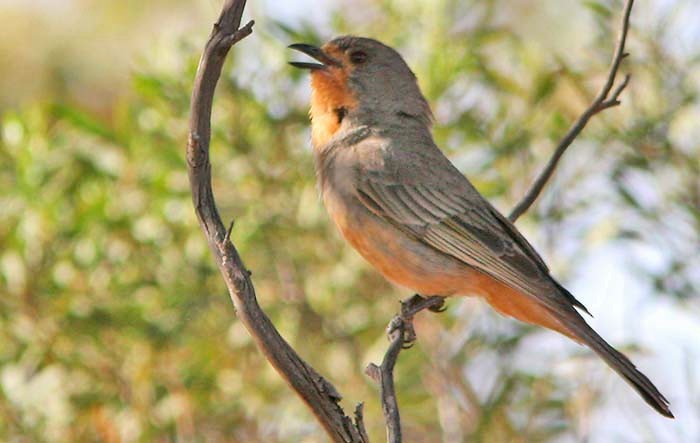Red-lored Whistler
A species of Typical whistlers Scientific name : Pachycephala rufogularis Genus : Typical whistlers
Red-lored Whistler, A species of Typical whistlers
Botanical name: Pachycephala rufogularis
Genus: Typical whistlers
Content
Description General Info
 Photo By Don Roberson
Photo By Don Roberson Description
The male has an orange/buff face and throat, a grey breastband extending around the neck and over the head and rufous underparts with pale yellow/olive edging to primaries. Some males are reported having a buff collar. The female is similar but with paler throat and underparts with a hint of buff. The eye is red, and bill and legs are dark. They weigh 30-38g and have a length of 19-22cm. Unlike other whistler species the throat colour of the Red-lored Whistler extends upwards to include the lores and face, distinguishing it from the closely related and similar Gilbert’s Whistler (Pacycephalas inornata) which also has a red throat. Females and juveniles of both species are very similar, making them harder to distinguish although the Red-lored Whistler has a slightly more buff colouring. Field identification is further compounded by the fact that the range of the Red-lored Whistler fits wholly within that of Gilbert’s Whistler. Both species share the same habitat and have similar behaviour and calls. John Gould, who described both species, was not familiar with the Gilbert's whistler at the time he identified the Red-lored Whistler: this is surprising, as the path that he travelled took him through areas where the Gilbert's whistler is not uncommon. It is possible that, in the absence of specimens, even Gould confused the two species. 
Size
22 cm
Nest Placement
Shrub
Feeding Habits
Red-lored Whistler mainly consumes arthropods, particularly insects, along with some seeds and fruits. Majority of foraging occurs below 0.5 meters, adopting gleaning techniques and occasionally sallying to feed, with most prey captured on the ground or in low vegetation.
Habitat
The red-lored Whistler typically inhabits low mallee woodlands characterized by multi-stemmed eucalypt trees with open canopies. These areas feature a moderately dense, yet patchy understorey, often including plant species like broombush and spinifex. The vegetation in these habitats is generally mature, with an age of at least five years post-disturbance.
Dite type
Insectivorous
General Info
Feeding Habits
Bird food type
Distribution Area
The Red-lored Whistler is a bird of the low mallee, spinifex, cypress pine and broombush woodland in the desert of central New South Wales, north-western Victoria and adjacent south-eastern South Australia, preferring low mallee woodlands or shrublands with open canopy, above a moderately dense but patchy scrub layer. Preferred vegetation has a post-fire age of 4-40 years, but it is most abundant in areas with a post fire age of 21-40 years. The species has long been regarded as sedentary, although the type specimen was collected in the Adelaide area suggesting some movement does occur. Generally restricted to the “Big Desert” or “Ninety-mile Desert” country of south-eastern South Australia and mostly limited to the Riverland Biosphere Reserve and it is now regularly observed north of the Murray River at Gluepot Reserve. The population on the Eyre Peninsula is thought to be extinct. In central New South Wales the Red-lored Whistler is restricted to the mallee within Round Hill Nature Reserve and nearby Nombinnie Nature Reserve where it is regularly observed, although it was previously recorded at Scotia in south-western New South Wales. In Victoria, the Red-lored Whistler can be found in the Ngarkat / Big Desert / Wyperfield complex and the Murray-Sunset / Hattah complex of National Parks. 
Species Status
Listed as Vulnerable on the IUCN Red List as at 1 October 2016 and in the Commonwealth Environment Protection and Biodiversity Conservation Act 1999 (EPBC Act), large parts of its range are protected, as National Parks and other reserves. The Red-lored Whistler is subject to a different conservation status in each State where it occurs. Population estimates in the year 2000 were around 10,000 and decreasing. The most recent estimate is not more than 2,000 mature individuals, with about half of these in the Riverland Biosphere Reserve. New South Wales: Critically endangered under the Threatened Species Conservation Act 1995 since 2009. South Australia: Vulnerable under the National Parks and Wildlife Act 1972. Victoria: Threatened under the Flora and Fauna Guarantee Act 1988. Under this Act, an Action Statement for the recovery and future management of this species has not yet been prepared. On the 2007 advisory list of threatened vertebrate fauna in Victoria, the Red-lored Whistler is listed as endangered. 

 Photo By Don Roberson
Photo By Don Roberson Scientific Classification
Phylum
Chordates Class
Birds Order
Perching birds Family
Whistlers and allies Genus
Typical whistlers Species
Red-lored Whistler